Bringing the festive mood straight to the table with this Homemade Cotechino. Slow-simmered, deeply comforting, and perfect for relaxed family meals all season long.

A few months ago, I took part in a Daring Cooks challenge about salumi. At the time, I chose to make Salame Cotto, and it turned out so well that it reminded me why I enjoy making these traditional meats at home.
Since I already prepare my own pork sausage often, it felt natural to try another classic, Cotechino. It looks like a large sausage with a different spice mix, and the real difference comes from the pork rind blended into the meat.

It takes about 10 minutes to prepare the mixture and 2-3 hours to cook it. Italians serve Cotechino on New Year’s Eve with lentils, and you can see how I make it in my Cotechino with Lentils recipe. We enjoy it through the colder months too, especially when we want something warm and comforting on the table.
You can find pre-cooked versions in many shops, and I am lucky to have an Italian butcher who makes fresh ones, but homemade always gives a cleaner flavour since it has no preservatives.
This is also why my homemade Cotechino is not reddish in colour, because that tone usually comes from nitrates. The appearance may be slightly different, yet the flavour is far better than the store-bought ones. Give it a try, and I am sure you will be pleased with the result. Enjoy!
Why We Love Homemade Cotechino
- Uses simple cuts that are easy to find and work surprisingly well together once ground and mixed.
- Gives you a reliable homemade option for holidays without needing anything complicated.
- Lets you skip preservatives, giving you a homemade result that tastes fresher and more balanced.
Key Ingredients for Homemade Cotechino
Pork Scotch Fillet
Gives the sausage structure with enough lean meat to keep it firm without drying during the long simmer.
Pork Rind
The rind is what makes cotechino tender. It melts slowly as it cooks, and grinding it well helps it blend into the mixture without leaving hard pieces.
Rashers Without Rind
Provide the fat needed for a soft, pleasant bite. The light saltiness they carry supports the seasoning already in the mix.
Red Wine
A splash of dry red wine brings the spices together and deepens the overall flavour. A small amount is enough for a noticeable difference.
Find the complete list with measurements in the recipe card below.
How to Make Homemade Cotechino
Step 1: Roughly chop the rind, the scotch fillet, and the rashers.
Step 2: Grind the rind using a 1.6 cm – 0.6 inch diameter grinder.
Step 3: Grind the scotch fillet, the rashers, and the already-ground rind using a 0.8 cm – 0.3 inch diameter grinder.
Step 4: Combine all the ground meat in a bowl, then add the salt, red wine, nutmeg, pepper, cinnamon, fennel seeds, garlic powder, and clove powder. Knead until well mixed.

Step 5: Stuff the mixture into the casing and tie the ends with a bubble knot.
Step 6: Leave it to rest, uncovered, at 20° to 25°C (68° – 77°F) for 24 hours before cooking.

Frequently Asked Questions
Yes. Place it in cold water, bring the cooker to high pressure, and cook for about 45 minutes. Let the pressure drop naturally.
It should feel cohesive and slightly sticky once the salt and wine have been worked through the meat. A uniform texture makes stuffing easier.
Large sausage casings or natural hog casings work as substitutes. Choose one long enough to hold the full mixture.
Press it gently with a spoon. It should feel firm, and the rind should be soft all the way through. A longer simmer is better than an undercooked centre.
Extra Help from the Kitchen
Chill the Grinder Parts – Cold plates and blades keep the meat firm, which helps it move through the grinder smoothly and hold its structure. This small step makes a clear difference in the final texture.
Trim the Rind Evenly – Cut the rind into small, consistent pieces so it feeds through the grinder without resistance. Uneven pieces can jam the grinder and affect how well the rind blends into the mixture.
Use a Narrow Spoon for Stuffing – A narrow spoon or sausage stuffer gives more control when filling the casing, especially as the mixture gets dense. This helps you form a tight, even sausage without overstretching the casing.
Tie Knots Firmly – Strong knots keep the mixture compact during the long simmer. A firm seal prevents gaps from forming and helps the cotechino keep its shape from end to end.
Variations and Twists
Cotechino al Barolo – Use Barolo instead of the usual red wine to give the mixture a fuller, rounder flavour that pairs well with the warm spices in this winter dish.
Cook with a Light Aromatic Base – Simmer the cotechino in water along with carrot, celery, and onion. These aromatics release a gentle flavour that settles into the meat as it cooks.
Serve with Lentils – Pair the sliced cotechino with a warm bowl of prepared lentils. Their earthy flavour sits well with the spices in the meat and makes a classic winter combination.
Storage and Shelf Life
Store raw cotechino in the fridge for up to 2 days, wrapped tightly to prevent drying. Store cooked cotechino in a sealed container in the fridge for 3 days.
Freeze it raw or cooked for as long as 2 months, keeping each piece well wrapped to protect the texture. Thaw overnight in the fridge. Reheat in a covered pan with a splash of water to keep it moist.
Sausage Recipes You’ll Love Making at Home

Homemade Cotechino Recipe
Bringing the festive mood straight to the table with this Homemade Cotechino. Slow-simmered, deeply comforting, and perfect for relaxed family meals all season long.
Ingredients
- 600 g – 1⅓ lbs pork scotch fillet
- 200 g – 7 oz pork rind
- 200 g – 7 oz rashers without rind
- 18 –20 g – 3¼ tsp salt
- 50 ml – ¼ cup red wine
- 3 g – 1 tsp peppercorns – crushed with a mortar and pestle
- ¼ tsp cinnamon
- ⅛ tsp fennel seeds
- ⅛ tsp nutmeg
- ⅛ tsp clove powder
- ⅛ tsp garlic powder
- Salami casing – soaked in tepid water for at least 20 minutes and rinsed
Instructions
-
Roughly chop the rind, the scotch fillet, and the rashers.
-
Grind the rind using a 1.6 cm – 0.6 inch diameter grinder.
-
Grind the scotch fillet, the rashers, and the already-ground rind using a 0.8 cm – 0.3 inch diameter grinder.
-
Combine all the ground meat in a bowl, then add the salt, red wine, nutmeg, pepper, cinnamon, fennel seeds, garlic powder, and clove powder. Knead until well mixed.
-
Stuff the mixture into the casing and tie the ends with a bubble knot.
-
Leave it to rest, uncovered, at 20° to 25°C (68° – 77°F) for 24 hours before cooking.
Recipe Notes
This cotechino has no preservatives, so you can keep it in the fridge, uncooked, for up to 3 days.



















I had not heard of cotechino before. It sounds delicious!!
I have to buy a meat grinder just to make this!
I’ve pinned this to try later. Also checked out the recipe with the lentils, we may be trying something new this New Year’s Eve! Looks delish, my family can never get enough salami and cheese.
I absolutely adore cotechino but I never thought of making it myself—until now, that is! Just one question: any idea what a pork scotch filet would be in the US? I Googled scotch filet and it ‘translates’ as ribeye steak, but that’s a beef cut, of course…
Hi Frank!
I had no idea pork scotch fillet had a different name in the USA and I could not find it either. That said, I have found this link http://www.pork.com.au/media/217373/Australian%20Pork%20Cuts%20Chart%20-%20low%20res.pdf that shows where a pork scotch fillet is in a pig… I think it may help. It is also called pork neck, but I think that’s more of a British term.
I can also say that in Italy we don’t use a scotch fillet for cotechini… we use all the left over meat for other cuts. So it doesn’t really matter too much what cut you use. I use a scotch fillet as it is soft and not too fat (it is the “parte magra – but not too lean” of my cotechino as I then add rashers and rind). I hope it helps! Let me know!
ITs called Boston Butt in the US
I live in St. Louis, Missouri, USA, and am lucky enough to live near a popular deli in the Italian section of the city named “Gioia’s” that serves a similar item called “salame di testa” or what most non-Italian locals refer to as “hot salami”. Salame di testa is popular in Northern Italy. A still-warm boiled pig’s head is boned, cut and mixed with spices, ground, cased, refrigerated overnight, then boiled, sliced and served hot. Gioia’s has been serving salame di testa since the early 1900s. If you’re ever in town, don’t miss it!
I have to say I love your recipes and this one is no exeption! Keep up the good work, congratulations!
What are rashers? Is that the same thing as bacon?
Rashers are thick slices of pork belly here in Australia.
You leave the sausage at room temp for 24 hrs after stuffing the casing?
Hi David. Only if it’s cold. Here in Australia, I now put it in the fridge just to be safe and it works out perfectly.